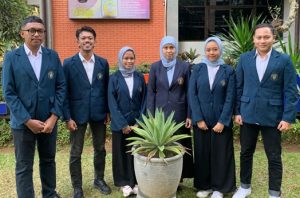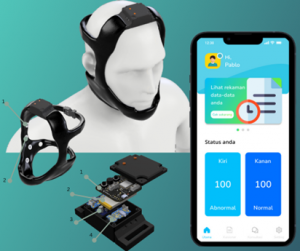UB Students Create Innovations for Jaw Injury Sufferers
Public awareness about diseases in dentistry is still relatively lacking. One of them is TMD (Temporomandibular Disorder), which is a temporomandibular disorder characterized by pain involving the temporomandibular joints, masticatory muscles, or muscles that supply the head and neck.
TMD is the main cause of non-dental pain involving the orofacial area. This disorder ranks second after chronic low back pain as a disorder that causes pain and disability.
One of the factors causing TMD is increased muscle activity (hyperactivity), which occurs continuously and causes muscle fatigue, resulting in disruption of nerve innervation and triggering pain in the area.
Examining or monitoring muscle activity in TMD sufferers is no less important than trying to carry out appropriate therapeutic measures to relieve pain.
Based on these problems, five Brawijaya University (UB) students created the Therapy and Monitoring Innovation for Temporomandibular Disorder (TEAMMATE).
 The five students are Handal Wally Akbar (Electrical Engineering 2021), Moh. Hibaturrohman Bagasunni’am (Electrical Engineering 2021), Rizki Bagus Hadi Kusuma (Electrical Engineering 2021), Salsabila Nurrin Ananda (Dentistry 2021), and Salsa Adilla Ilianis (Dentistry 2021).
The five students are Handal Wally Akbar (Electrical Engineering 2021), Moh. Hibaturrohman Bagasunni’am (Electrical Engineering 2021), Rizki Bagus Hadi Kusuma (Electrical Engineering 2021), Salsabila Nurrin Ananda (Dentistry 2021), and Salsa Adilla Ilianis (Dentistry 2021).
This innovation is in the form of an Internet of Things (IoT) integrated monitoring and therapy tool connected to an application. The tool was created as an effort to monitor muscle activity and non-invasive analgesics to relieve TMD pain.
In addition, information is provided on exercise as a long-term therapy. This application also makes communication between doctors and TMD patients easier.
Under the guidance of Ir. Nurussa’adah, M.T., this work successfully obtained research funding in the 2023 Student Creativity Program in the field of Creative Initiatives.
Although temporomandibular disorders are often ignored by many people, increasingly advanced conditions can reduce the sufferer’s quality of life.
“If it continues, it can involve speech and chewing functions, and can affect the growth and development of the face or jaw,” explained one team member, Bagas.
There are two ways TEAMMATE works, said another team member, Nuril, namely a monitoring system and a therapy system. The monitoring system is recorded using surface electromyography (EMG) electrodes to determine the condition of the masseter and temporalis muscles when they contract and relax.
“With this monitoring system. Users can find out the classification of TMD severity through the condition of their muscles. “Therefore, doctors can also suggest activities that should be avoided as well as appropriate exercise so that muscle disorders do not get worse and the condition improves,” said Salsa.
 In the therapy system, it is carried out spontaneously and long term. Spontaneous therapy can utilize the TENS method with a voltage output of 0-50 Volts and a frequency of 100 Hz found on the TEAMMATE faceband.
In the therapy system, it is carried out spontaneously and long term. Spontaneous therapy can utilize the TENS method with a voltage output of 0-50 Volts and a frequency of 100 Hz found on the TEAMMATE faceband.
With a duration of use of 15-25 minutes, which will be determined by the doctor in charge, this therapy aims to relieve pain. Long-term therapy uses the exercise feature found in the TEAMMATE application.
“We designed TEAMMATE ergonomically so that users are comfortable using the tool. Plus, we made it to fit a variety of head sizes. The size of this tool is not too big, so it can be used anytime and anywhere when TMD sufferers feel pain,” said Bagus.
TEAMMATE can provide information regarding the history of abnormalities in the contraction or relaxation of masticatory muscles in TMD sufferers with a monitoring system.
Apart from that, TEAMMATE can help doctors find out the condition of the patient’s chewing muscles and recommend appropriate exercise from the results of electromyography sensor monitoring readings monitored by doctors remotely in real-time.
“Users can use an electromyography sensor to determine jaw muscle activity. When abnormal jaw muscle activity occurs, the doctor’s application will display data on the muscle activity so that they can suggest therapy that should be carried out,” explained Handal as team leader.
“TEAMMATE has great potential to be traded. In the next development, the dimensions of the TEAMMATE electrical box will be reduced, adding a step-up series to the TEAMMATE PCB, making it lighter to increase comfort,” explained Ir. Nurussa’adah, M.T. as the main supervisor.
The addition of the application of Artificial Intelligence to TEAMMATE makes TEAMMATE technology even more accurate and effective in terms of data processing for information on patient conditions.
TEAMMATE presents an innovation that is a solution to the problem of TMD, aimed at preventing pain as a substitute for using analgesics, and can be monitored in real-time anywhere because it is integrated.

